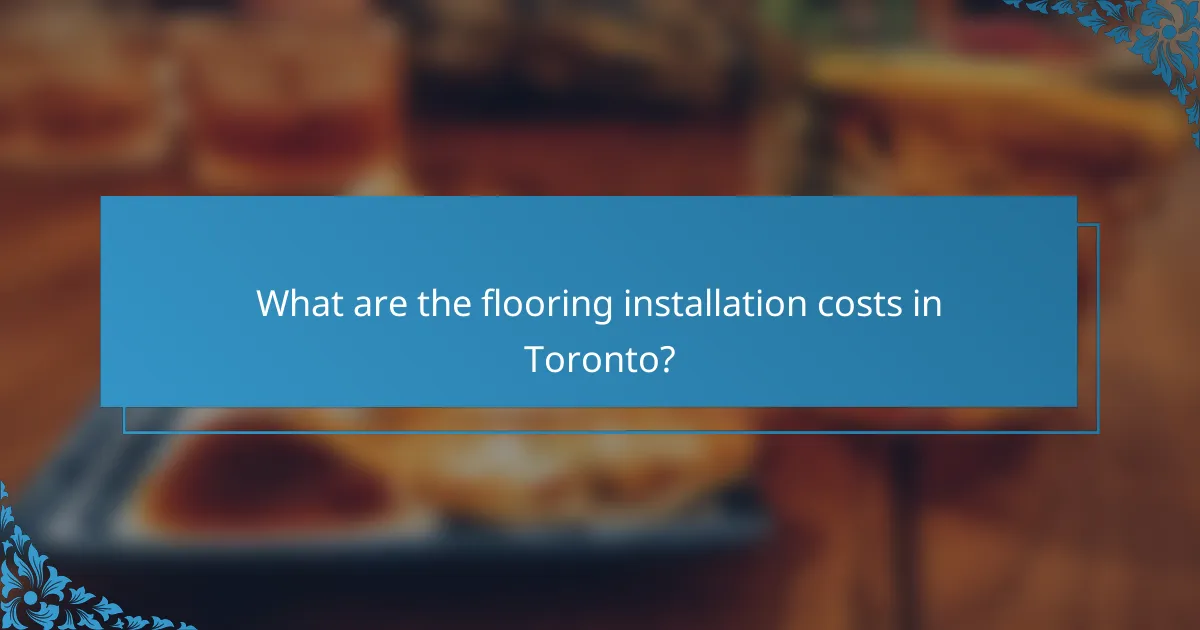Flooring installation costs can vary widely depending on the material selected and the intricacies of the installation process. Homeowners in Toronto typically face expenses ranging from CAD 5 to CAD 15 per square foot, encompassing both materials and labor. With a variety of options like hardwood, vinyl, laminate, tile, and carpet available, each choice brings its own set of benefits and considerations that can impact the overall project cost and quality.

What are the flooring installation costs in Toronto?
The flooring installation costs in Toronto can vary significantly based on the type of material chosen and the complexity of the installation. Generally, homeowners can expect to pay anywhere from CAD 5 to CAD 15 per square foot for materials and labor combined.
Average cost per square foot
The average cost per square foot for flooring installation in Toronto typically ranges from CAD 5 to CAD 15. For instance, laminate flooring may cost around CAD 5 to CAD 8 per square foot, while hardwood can range from CAD 8 to CAD 15. Luxury vinyl tiles often fall in the middle, averaging CAD 6 to CAD 10 per square foot.
These costs usually include both the material and the labor required for installation. However, additional expenses such as underlayment, removal of old flooring, and any necessary repairs can increase the overall price.
Factors affecting installation costs
Other considerations include the size of the area being covered, the condition of the subfloor, and any additional services required, such as moving furniture or preparing the site. Homeowners should also factor in potential seasonal pricing fluctuations, as demand can affect labor rates during peak renovation seasons.

What types of flooring materials are available in Canada?
In Canada, homeowners can choose from a variety of flooring materials, each offering unique benefits and aesthetic qualities. Popular options include hardwood, vinyl, laminate, tile, and carpet, with considerations for durability, cost, and maintenance varying across these materials.
Hardwood flooring options
Hardwood flooring is a classic choice known for its durability and timeless appeal. Common species available in Canada include oak, maple, and cherry, each offering distinct colors and grain patterns. Prices typically range from CAD 5 to CAD 15 per square foot, depending on the wood type and finish.
When selecting hardwood, consider factors such as the room’s humidity and foot traffic. Engineered hardwood is a suitable alternative for areas with fluctuating moisture levels, as it is more resistant to warping compared to solid hardwood.
Vinyl flooring choices
Vinyl flooring is a versatile and cost-effective option, ideal for high-traffic areas and moisture-prone spaces like kitchens and bathrooms. Available in sheets, tiles, or planks, vinyl can mimic the appearance of natural materials at a lower price point, generally ranging from CAD 2 to CAD 7 per square foot.
When choosing vinyl, look for options with a thicker wear layer for added durability. Luxury vinyl tiles (LVT) offer enhanced aesthetics and can be installed with a click-lock system, making them a popular DIY choice.

How does the installation process work?
The flooring installation process involves several key steps, including preparation, material selection, and the actual installation techniques. Understanding these steps helps ensure a smooth installation and can influence the overall cost and quality of the flooring project.
Preparation steps for flooring installation
Preparation is crucial for a successful flooring installation. Begin by clearing the area of furniture and debris, ensuring the subfloor is clean, dry, and level. This may involve repairing any damage or imperfections in the subfloor to create a stable base for the new flooring.
Next, acclimate the flooring materials to the room’s temperature and humidity for several days before installation. This helps prevent warping or buckling after the flooring is laid. Finally, gather all necessary tools and materials, including underlayment, adhesives, and trim pieces, to streamline the installation process.
Installation techniques for different materials
Different flooring materials require specific installation techniques. For example, hardwood flooring is typically installed using nail-down or glue-down methods, while laminate flooring often employs a floating installation technique that allows for expansion and contraction. Each method has its own set of tools and requirements.
Tile flooring usually involves a mortar bed and grout, requiring precise cutting and placement to ensure a professional finish. Vinyl flooring can be installed as peel-and-stick tiles or sheet vinyl, which may require less preparation and can be more forgiving for DIY installations. Understanding these techniques helps in selecting the right material based on your skill level and project needs.

What are the pricing bands for flooring installation services?
Flooring installation services typically range from budget-friendly options to premium solutions, with costs varying based on material choice, labor, and location. Generally, homeowners can expect to pay anywhere from a few dollars to over twenty dollars per square foot for installation, depending on these factors.
Budget-friendly flooring options
Budget-friendly flooring options include materials such as laminate, vinyl, and carpet tiles, which usually cost between 1 to 5 USD per square foot for materials and installation. These choices are ideal for homeowners looking to minimize expenses while still achieving a decent aesthetic.
When selecting budget-friendly flooring, consider durability and maintenance. For instance, vinyl is water-resistant and easy to clean, making it suitable for high-traffic areas. However, it may not offer the same longevity as more expensive materials.
Premium flooring installation costs
Premium flooring options, such as hardwood, natural stone, or high-end tiles, can range from 5 to over 20 USD per square foot for materials and installation. These materials not only enhance the aesthetic appeal of a home but also tend to increase property value.
Investing in premium flooring requires careful consideration of installation costs, which can vary significantly based on the complexity of the job. For example, intricate patterns or custom installations may incur additional labor charges. Always obtain multiple quotes to ensure competitive pricing and quality workmanship.

What permits are required for flooring installation in Ontario?
In Ontario, flooring installation typically requires building permits, especially for significant renovations or structural changes. Homeowners should check with their local municipality to understand specific permit requirements and ensure compliance with regulations.
Building permits for residential projects
Building permits are often necessary for residential flooring projects that involve alterations to the structure, such as removing walls or changing the layout. The cost of these permits can vary, generally ranging from a few hundred to over a thousand Canadian dollars, depending on the scope of the work and the municipality.
To obtain a building permit, homeowners must submit detailed plans and specifications of the proposed work. It’s advisable to consult with a licensed contractor or architect to ensure all documentation meets local standards.
Compliance with local regulations
Compliance with local regulations is crucial when installing flooring in Ontario. Each municipality has its own building codes that dictate safety and structural integrity standards, which must be adhered to during installation.
Homeowners should familiarize themselves with these regulations, as non-compliance can lead to fines or the need to redo work. Checking with local building authorities before starting the project can help avoid potential issues and ensure a smooth installation process.

How long does flooring installation typically take?
Flooring installation usually takes anywhere from a few hours to several days, depending on the type of flooring and the complexity of the project. Simple installations, like vinyl or laminate, can be completed quickly, while hardwood or tile may require more time for proper fitting and drying.
Time estimates for different materials
Different flooring materials have varying installation times. For instance, laminate and vinyl flooring can often be installed in one to two days, while hardwood flooring might take two to four days due to the need for acclimation and multiple coats of finish. Tile installation can take longer, typically three to five days, especially if intricate patterns are involved.
Here’s a quick overview of estimated installation times for common flooring types:
- Laminate: 1-2 days
- Vinyl: 1-2 days
- Hardwood: 2-4 days
- Tile: 3-5 days
Factors influencing installation duration
Weather conditions can also impact installation, particularly for materials that require adhesive or drying time. It’s advisable to schedule installations during mild weather to avoid delays. Lastly, the experience level of the installers can influence speed; professional teams may complete the job more efficiently than less experienced workers.

What are the benefits of professional flooring installation?
Professional flooring installation offers significant advantages, including expert craftsmanship and time efficiency. Hiring skilled installers ensures that your flooring is laid correctly, minimizing future repair costs and enhancing the overall aesthetic of your space.
Quality assurance from experts
When you opt for professional flooring installation, you benefit from the expertise of trained professionals who understand the nuances of different materials and techniques. This knowledge translates into a higher quality finish, as they can identify potential issues before they arise and ensure that your flooring meets industry standards.
For example, a professional installer can recommend the best type of flooring for your specific environment, whether it be moisture-resistant options for basements or durable materials for high-traffic areas. This tailored approach helps avoid common pitfalls that DIY installations often encounter.
Warranty and support options
Many professional flooring services offer warranties that cover both the materials and the installation work. This means that if any issues arise within a specified period, you can have them addressed without incurring additional costs. Warranties typically range from a few years to a lifetime, depending on the product and service provider.
Additionally, professional installers often provide ongoing support, ensuring that you have access to assistance if you encounter problems or have questions about maintenance. This peace of mind is invaluable, especially for significant investments like flooring.

What are the latest trends in flooring materials?
Current trends in flooring materials focus on sustainability, durability, and aesthetic appeal. Homeowners are increasingly opting for eco-friendly options like bamboo and reclaimed wood, as well as versatile materials such as luxury vinyl and laminate that mimic natural surfaces.
Eco-friendly flooring options
Eco-friendly flooring materials are gaining popularity due to their minimal environmental impact. Options like bamboo, cork, and reclaimed wood not only reduce deforestation but also offer unique aesthetics. These materials often come with certifications, ensuring they meet sustainability standards.
Luxury vinyl and laminate trends
Luxury vinyl and laminate flooring are trending due to their affordability and versatility. They can replicate the look of hardwood or stone while being more resistant to moisture and wear. Prices for luxury vinyl typically range from $2 to $7 per square foot, making it a cost-effective choice for many homeowners.
Textured and patterned surfaces
Textured and patterned flooring surfaces are becoming increasingly popular as they add depth and character to spaces. These designs can range from subtle textures to bold patterns, allowing for personalization in home decor. When choosing textured options, consider maintenance, as some patterns may require more cleaning effort.
